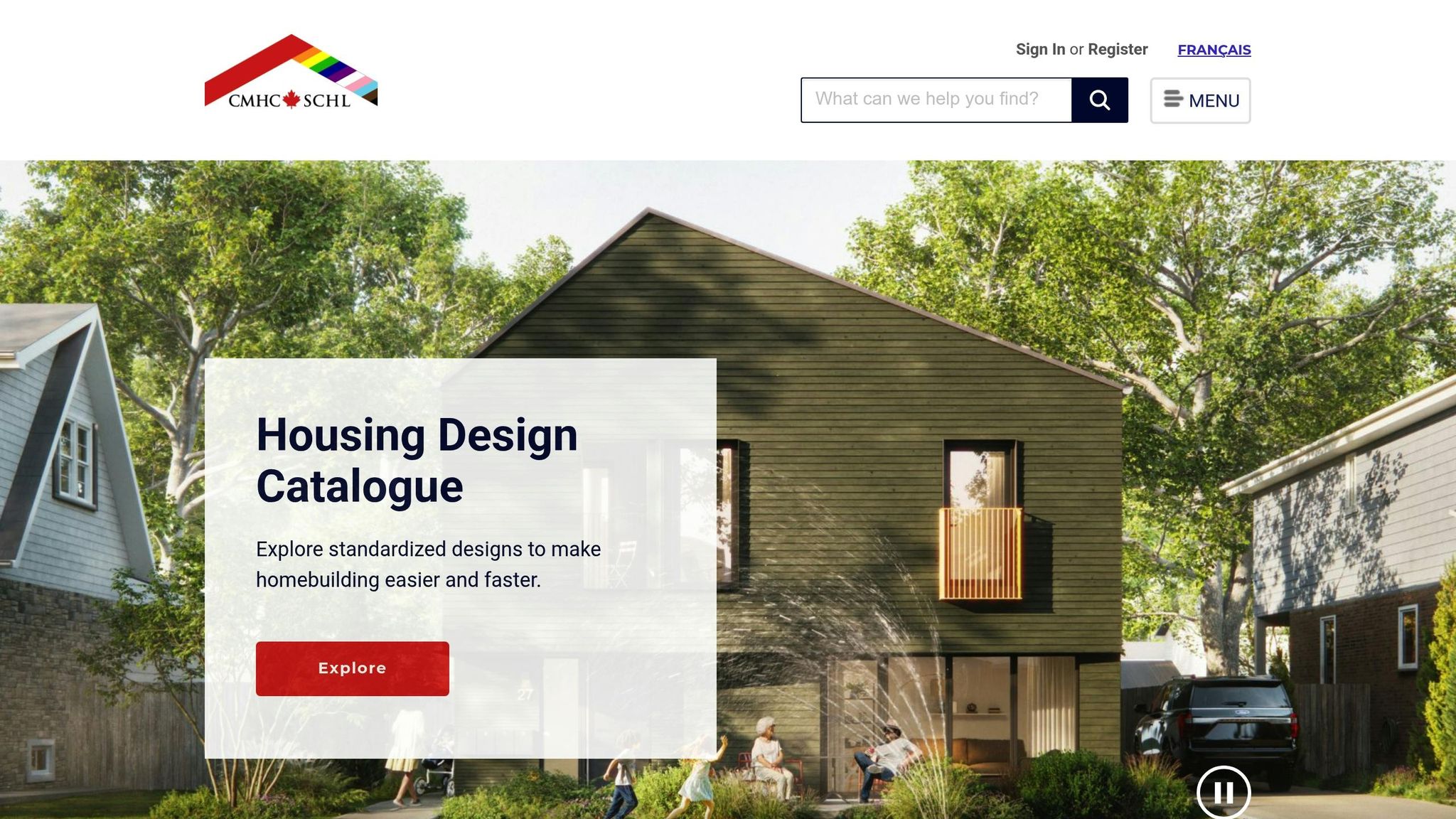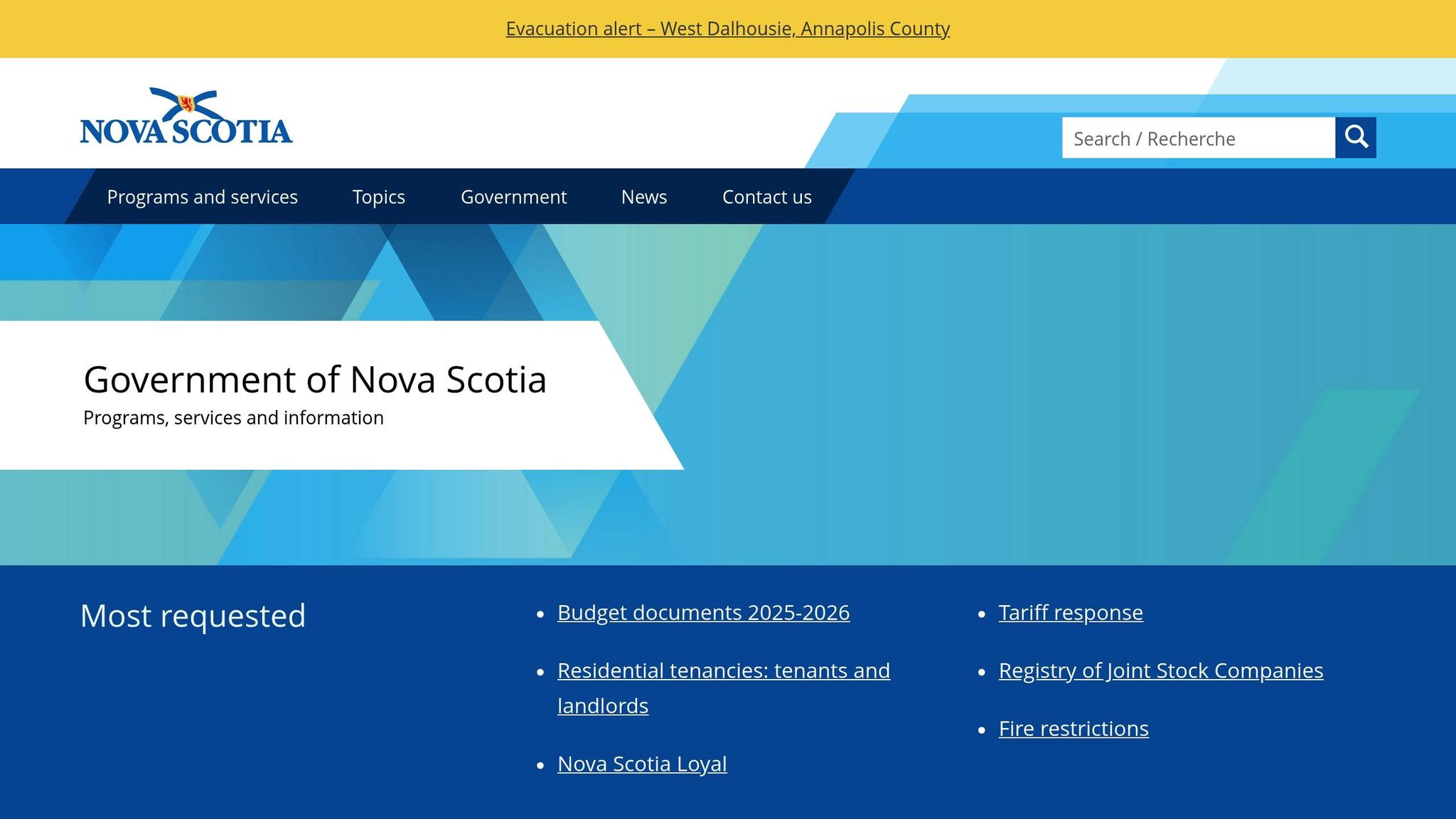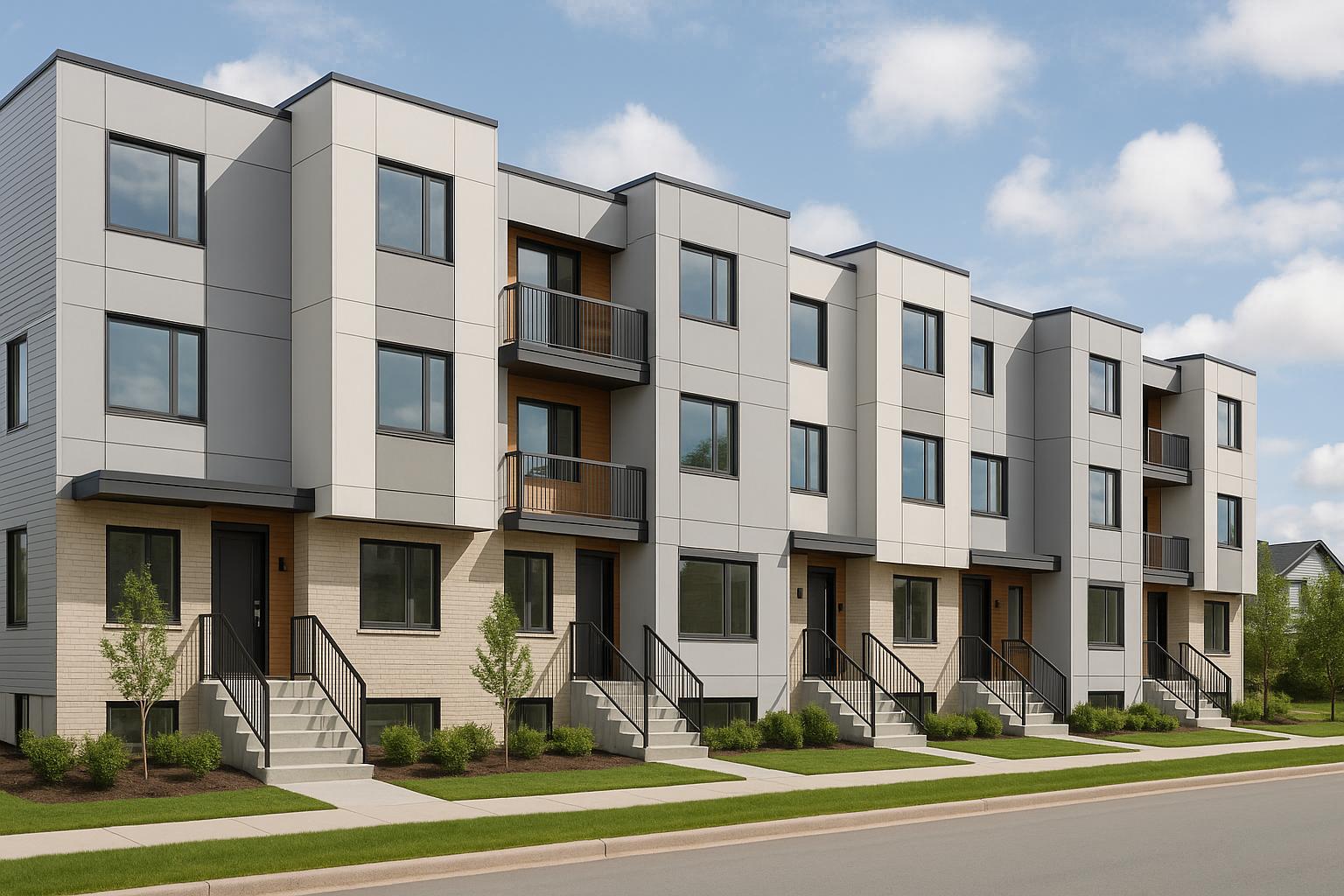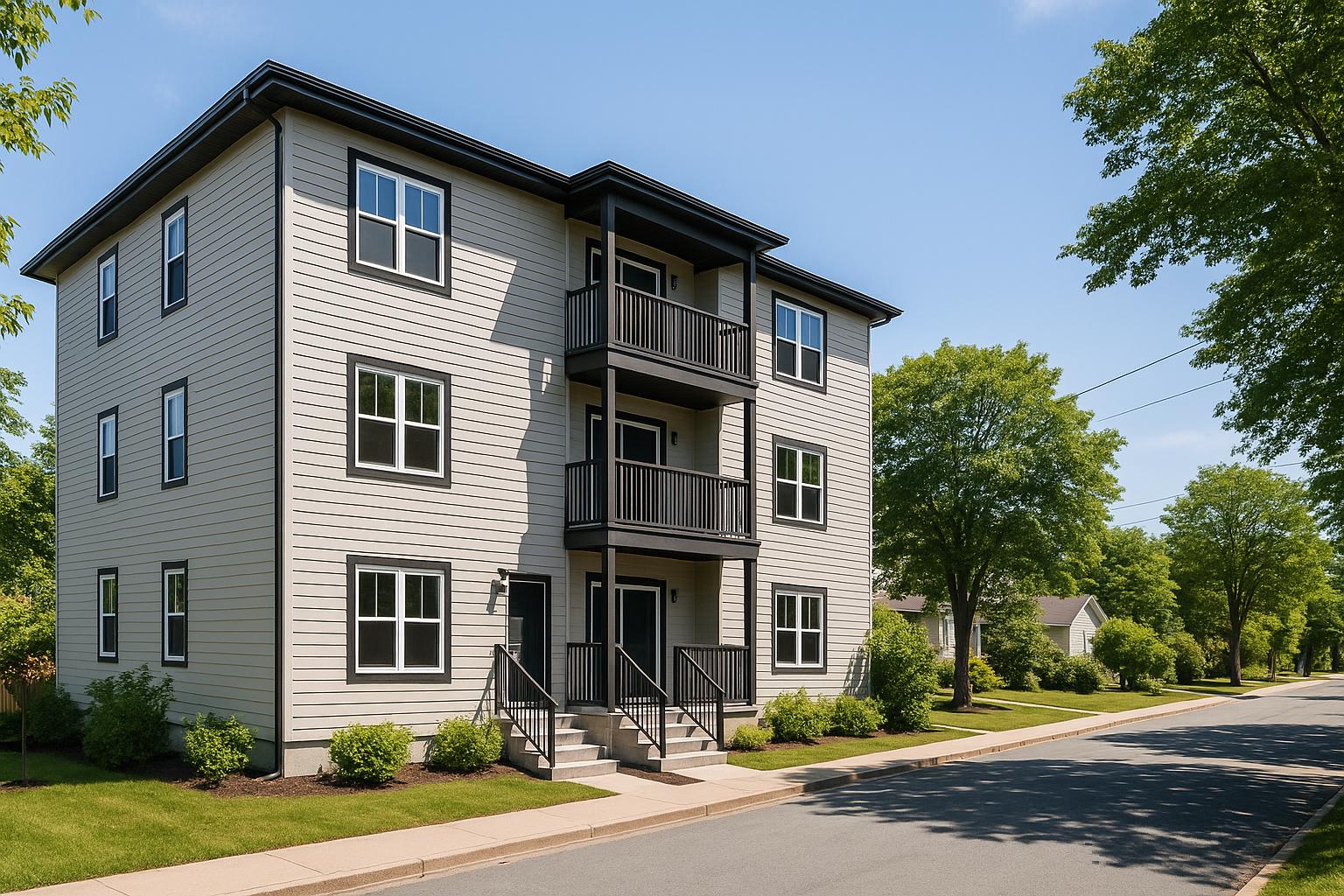Building rental properties in Halifax’s ER-3 zones just got easier with CMHC’s MLI Select program. This initiative rewards projects that focus on affordability, accessibility, and energy efficiency with better financing terms. Here’s what you need to know:
- Key Benefits: Up to 95% financing, 50-year amortization, and lower upfront costs.
- Eligibility: Projects must have at least five units, with non-residential space capped at 30% of the building’s total area.
- ER-3 Zoning: Allows up to 8 units per lot, with flexible lot coverage rules and no minimum parking requirements.
- Market Rents: Two-bedroom units in Halifax rent for $1,950–$2,100/month, depending on location.
- Construction Costs: Standard builds cost ~$160,000/unit, while MLI Select-compliant builds cost ~$200,000/unit due to energy-efficient upgrades.
Why it matters: Halifax faces a housing shortage, with 18,000 units needed now and 52,000 by 2027. MLI Select makes it easier for property owners to contribute to this supply while improving cash flow and long-term returns.
For smoother approvals and compliance, consider working with integrated design-build firms that handle everything from planning to construction under one roof.
Understanding CMHC MLI Select Financing [June 2024]

CMHC Underwriting Process for ER-3 Projects
This section sheds light on the underwriting process that ensures ER-3 project success under CMHC's MLI Select program. The process evaluates your project's financial feasibility and alignment with program objectives. Familiarizing yourself with CMHC's documentation requirements early can simplify and accelerate the approval journey.
Required Documents and Eligibility Rules
To assess an ER-3 project under the MLI Select program, CMHC requires thorough documentation. The application relies on a points-based system that evaluates affordability, energy efficiency, accessibility, and social outcomes. Applicants must provide evidence of meeting these criteria through comprehensive documentation.
- Energy Efficiency: Submit certified energy modelling reports that outline building specifications and demonstrate improvements over baseline standards.
- Accessibility: Provide architectural drawings and professional certifications confirming that the design meets accessibility requirements, such as barrier-free layouts and accessible entrances.
- Appraisals: Include appraisal reports that follow industry standards, using three market valuation methods. Ensure the valuation date is within 12 months of submission. These appraisals should confirm that projected rental income aligns with local market conditions.
- Financial Documentation: Supply detailed budgets, cash flow projections, and confirmed equity to show that rental income can cover debt over the extended amortization period.
How Integrated Design-Build Speeds Up Approvals
An integrated design-build approach weaves MLI Select criteria into the project from the beginning. This method brings together designers and contractors from the outset, ensuring accountability for both quality and timelines [2]. The team is responsible for every phase of the project, from initial design to construction completion [2][3].
By addressing all project costs early, this approach establishes realistic timelines and budgets that align with CMHC's underwriting standards. For instance, Helio Urban Development employs a model where planners, architects, engineers, and construction teams work as a single cohesive unit, ensuring all required documentation is ready from the start.
This collaborative approach not only simplifies the approval process but also aligns with Nova Scotia's specific application requirements, discussed below.
Nova Scotia Application Process Details

In Nova Scotia, CMHC applications may involve additional regional considerations. Local municipal processes - such as planning approvals and building permits - can significantly impact project timelines. These regional factors underscore the importance of a comprehensive and integrated approach. Working with local experts can help navigate municipal planning and permitting processes, ensuring smoother and faster project approvals.
Nova Scotia Rental Income and Market Rates
If you're working on an ER-3 project under CMHC's MLI Select program, understanding rental rates is key to assessing cash flow and overall return on investment. Here's a closer look at current market rents and how energy efficiency can influence rental income.
Current Market Rent Rates
In Halifax, the typical rent for two-bedroom units - commonly featured in ER-3 developments - ranges from $1,950 to $2,100 per month. The exact rent often depends on the location. Units closer to downtown Halifax or Dartmouth generally fetch rents at the higher end of this range. In contrast, properties in suburban areas like Bedford, Sackville, and Cole Harbour tend to fall closer to the middle.
The Role of Energy Efficiency in Rent Prices
MLI Select-certified buildings are built to be 40% more energy efficient than standard code requirements. Features like triple-pane windows and ductless heat pumps not only reduce energy consumption but also improve tenant comfort. These perks can make units more appealing, potentially leading to quicker lease-ups and steady occupancy rates.
Comparing Standard and MLI Select Units
Here’s a breakdown of how standard construction compares to MLI Select construction in terms of rent, costs, and returns:
| Construction Type | Expected Monthly Rent Range | Construction Cost | Annual ROI Range | Key Advantages |
|---|---|---|---|---|
| Standard Construction | $1,950 – $2,100 | $160,000/unit | 12–16% | Lower upfront costs and traditional financing options. |
| MLI Select Construction | $1,950 – $2,100 | $200,000/unit | 15–20% | Access to 95% financing with a 50-year term and improved energy performance. |
Though MLI Select construction comes with higher upfront costs, the program’s favourable financing - like higher loan-to-value ratios and extended amortization - ensures projects can start generating positive cash flow right away.
sbb-itb-16b8a48
Construction Costs and Financing Options
Grasping the financial details of ER-3 projects is crucial for property owners aiming to make smart decisions about construction methods and funding strategies. These financial insights are particularly important when considering the benefits of CMHC MLI Select for ER-3 builds. The decision between a conventional construction model and one that qualifies for MLI Select affects not just initial costs but also the long-term financial outlook of the project.
ER-3 Project Construction Cost Ranges
For a standard four-unit ER-3 project, construction costs are approximately $160,000 per unit, which totals $640,000. This pricing reflects energy-efficient designs and quality finishes.
If the project is built to MLI Select standards, the cost rises to about $200,000 per unit, bringing the total to $800,000 for four units. The additional $40,000 per unit covers advanced energy efficiency features that exceed baseline code requirements by 40%. Achieving this involves using specialized materials and precise installation methods to meet CMHC's stringent energy standards. While these upgrades increase upfront costs, they are balanced by more favourable financing terms.
Financing Advantages with CMHC MLI Select
Financing terms are a game-changer when it comes to project economics. MLI Select offers 95% financing, which means only a 5% down payment is required (e.g., $40,000 for an $800,000 project). This results in a leverage ratio of 20:1, compared to the 5:1 leverage typical of standard construction financing. Additionally, MLI Select allows for extended amortization periods of up to 50 years, reducing periodic payments and improving cash flow from day one.
This financing structure not only lowers the initial capital needed but also frees up funds for reinvestment, enabling faster portfolio expansion. The combination of reduced upfront costs and improved cash flow makes MLI Select an attractive option for property owners focused on long-term growth.
Cost and Financing Comparison Table
| Project Type | Total Construction Cost (4 Units) | Down Payment Required | Leverage Ratio |
|---|---|---|---|
| Standard Construction | $640,000 | 20% ($128,000) | 5:1 |
| MLI Select Construction | $800,000 | 5% ($40,000) | 20:1 |
Avoiding Construction Problems with Integrated Building
Building ER-3 multi-unit rentals in Halifax comes with its fair share of challenges. Labour shortages, soaring material costs, and rising financing rates make traditional construction methods especially risky in this market [4]. These factors only add to the inherent risks of fragmented construction approaches.
Problems with Typical Construction Methods
Fragmented construction - where different firms handle planning, architecture, engineering, and construction - often leads to poor coordination. In Halifax, this disjointed approach has resulted in cost overruns ranging from 30% to 60% and project timelines stretching from an expected 8 months to over 18 months. For property owners, these delays can mean substantial financial losses. For example, a four-unit ER-3 project generating about $8,000 in monthly rental income could lose tens of thousands of dollars due to extended timelines. Additionally, cost-plus pricing models in traditional construction expose owners to market fluctuations, with unexpected increases in material and labour costs being passed along without much recourse.
Benefits of Integrated Design-Build
Integrated design-build firms, such as Helio Urban Development, tackle these issues by managing all aspects of a project under one roof. This approach provides a single point of accountability, simplifying the process for property owners.
Fixed-price contracts ensure cost certainty, eliminating the risk of overruns. Additionally, integrated firms often offer timeline guarantees - such as a six-month completion deadline with a $1,000 per day penalty for delays - giving property owners a predictable schedule they can rely on.
Quality control is another key advantage. Integrated firms implement a triple verification system, including five P.Eng inspections during construction. Property owners also have the option to choose the final inspector, further reducing the risk of quality issues. Daily photo updates and a real-time project portal keep owners informed without requiring constant site visits, offering transparency throughout the build.
Construction Method Comparison
| Aspect | Traditional Fragmented Construction | Integrated Design-Build |
|---|---|---|
| Cost Certainty | Cost-plus pricing; 30–60% overruns common | Fixed pricing with no overruns guaranteed |
| Timeline Reliability | 12–18 months with frequent delays | 6-month completion guarantee with $1,000/day penalty |
| Accountability | Multiple contracts with unclear responsibilities | Single point of accountability |
| Quality Control | Fragmented oversight with inconsistent standards | Triple verification system with regular P.Eng inspections |
| Communication | Multiple reporting systems with frequent gaps | Daily updates and real-time access via a project portal |
| Risk Management | Property owner bears most coordination risks | Builder assumes full delivery risk |
This integrated approach is particularly advantageous for ER-3 projects seeking CMHC MLI Select financing. The program’s energy efficiency requirements and detailed documentation demand seamless coordination between design and construction teams. When these responsibilities are divided among separate firms, miscommunication can lead to non-compliance with CMHC standards, potentially jeopardizing benefits like 95% financing and 50-year amortization. By consolidating these tasks, integrated design-build firms ensure projects meet CMHC’s stringent standards while streamlining the overall process.
With Halifax experiencing rapid growth - it ranked as Canada’s second-fastest growing urban region with a population increase of about 20,000 people (4.5% growth) from July 2021 to July 2022 - rental housing demand is outstripping supply [4]. Property owners who choose an integrated design-build method can better position themselves to meet this demand, avoiding the delays and cost overruns that plague traditional construction methods.
Getting the Most from CMHC MLI Select for ER-3 Properties
Using the CMHC MLI Select program can help you secure favourable financing for ER-3 rental properties while improving the overall profitability of your projects. The program operates on a point-based system that rewards developers for prioritizing affordability, energy efficiency, and accessibility - key factors that can significantly influence your project's financial performance.
To maximize your points, consider dedicating a portion of your units to affordable rent. For instance, offering 25% of your units at 30% of the median renter income can earn you 100 points. Extending this affordability commitment to more than 20 years adds another 30 points to your score. Accessibility is another area where you can gain points. Ensuring all units meet 100% visitability standards under CSA B651:23 and making common areas barrier-free not only enhances your project's inclusivity but also strengthens your financing application. Additionally, meeting eligibility criteria - such as limiting non-residential space to 30% of the gross floor area or total lending value - further positions your project for success [1].
Energy efficiency plays a major role in the program as well. While standard construction in Nova Scotia typically costs around $160,000 per unit, building to CMHC MLI Select standards generally raises that cost to approximately $200,000 per unit. However, these higher upfront expenses come with significant benefits: up to 95% financing and a 50-year amortization period. These terms reduce the equity required and can improve monthly cash flow, making the investment more manageable and potentially more profitable.
An integrated design-build approach is particularly advantageous for MLI Select projects. Meeting the program's energy efficiency and documentation standards requires close collaboration between design and construction teams. For example, Helio Urban Development uses this integrated method to streamline the process, reducing the coordination issues that often arise in more fragmented construction models. This approach ensures your project is not only compliant but also optimized for financial success.
The financial benefits of MLI Select are clear. Lower down payments - as little as 5% compared to the traditional 20% - combined with extended amortization terms, can significantly reduce monthly carrying costs and improve cash flow from day one.
Achieving success with CMHC MLI Select requires careful planning and professional execution. The program's complexity means it's essential to work with builders who understand both the construction requirements and the CMHC documentation process. By partnering with an experienced, integrated design-build firm, you can navigate these challenges effectively, secure financing approval, and set your project up for long-term success.
FAQs
What advantages does the CMHC MLI Select program offer for multi-unit rental projects in Halifax's ER-3 zones?
The CMHC MLI Select program offers substantial advantages for property owners planning to develop 4 to 24-unit rental properties within Halifax's ER-3 zones. One of the standout benefits is the opportunity to secure up to 95% financing, which can significantly ease the financial burden of getting your project off the ground.
The program also includes incentives for energy efficiency, helping to lower operating costs while aligning your development with Nova Scotia's environmental goals. On top of that, it provides amortization periods of up to 50 years, which can enhance cash flow and boost the overall profitability of your property.
With these features, the program is a strong option for those aiming to invest in affordable, energy-efficient housing while making the most of their financial resources.
What are the benefits of using an integrated design-build approach for ER-3 zoned projects under the CMHC MLI Select program?
An integrated design-build approach streamlines the development of ER-3 zoned multi-unit rental projects under the CMHC MLI Select program by merging design and construction into a unified process. This method allows property owners to have greater control over costs, timelines, and quality, minimizing the risks of delays and budget overruns that are common with more traditional, fragmented approaches.
By bringing all stakeholders together from the outset, this approach ensures smoother communication and quicker decision-making, leading to faster and more predictable project completion. It’s an ideal solution for Nova Scotia’s rental market, where efficiency and profitability are critical for smaller-scale multi-unit developments.
What are the differences in costs and financing between standard builds and MLI Select-compliant projects in Halifax?
In Halifax, the CMHC MLI Select program offers financing terms that are far more flexible than those for standard builds. With options like up to 95% loan-to-value (LTV) and a 50-year amortization, property owners can kick off their projects with as little as a 5% down payment. These terms are structured to ease cash flow and make multi-unit rental developments more attainable.
That said, construction costs for projects that meet MLI Select requirements tend to be higher, averaging around CA$200,000 per unit. However, the program’s financing perks often outweigh these upfront costs. By comparison, standard builds usually come with stricter financing terms and steeper initial expenses, making MLI Select a more attractive choice for many Halifax property owners.



